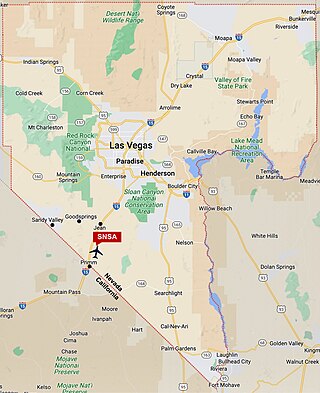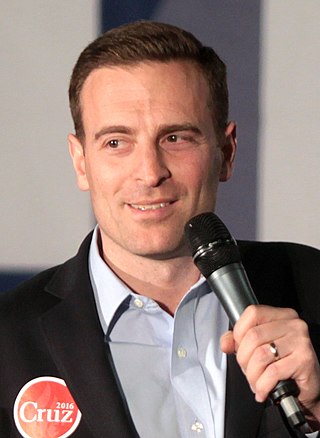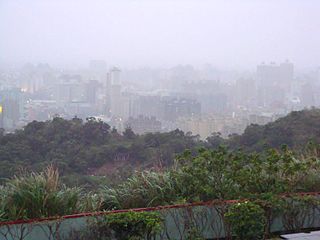
Las Vegas, often known as Sin City or simply Vegas, is the most populous city in the U.S. state of Nevada and the seat of Clark County. The Las Vegas Valley metropolitan area is the largest within the greater Mojave Desert, and second-largest in the Southwestern United States. Las Vegas is an internationally renowned major resort city, known primarily for its gambling, shopping, fine dining, entertainment, and nightlife, with most venues centered on downtown Las Vegas and more to the Las Vegas Strip just outside city limits. The Las Vegas Valley as a whole serves as the leading financial, commercial, and cultural center for Nevada. According to the United States Census Bureau, the city had 641,903 residents in 2020, with a metropolitan population of 2,227,053, making it the 25th-most populous city in the United States.

Clark County is a county located in the U.S. state of Nevada, which also comprises the Las Vegas-Henderson-North Las Vegas, NV Metropolitan Statistical Area. The land area of Clark County is 8,061 square miles (20,880 km2), or roughly the size of New Jersey. As of the 2020 census, the population was 2,265,461. Most of the county population resides in the Las Vegas Census County Divisions, which has 2,196,623 people as of the 2020 Census. It is by far the most populous county in Nevada, and the 11th-most populous county in the United States. It covers 7% of the state's land area but holds 73% of the state's population, making Nevada the most centralized state in the United States.

The Environmental Protection Agency (EPA) is an independent agency of the United States government tasked with environmental protection matters. President Richard Nixon proposed the establishment of EPA on July 9, 1970; it began operation on December 2, 1970, after Nixon signed an executive order. The order establishing the EPA was ratified by committee hearings in the House and Senate.

The Las Vegas Valley is a major metropolitan area in the southern part of the U.S. state of Nevada, and the second largest in the Southwestern United States. The state's largest urban agglomeration, the Las Vegas Metropolitan Statistical Area is coextensive since 2003 with Clark County, Nevada. The Valley is largely defined by the Las Vegas Valley landform, a 600 sq mi (1,600 km2) basin area surrounded by mountains to the north, south, east and west of the metropolitan area. The Valley is home to the three largest incorporated cities in Nevada: Las Vegas, Henderson and North Las Vegas. Eleven unincorporated towns governed by the Clark County government are part of the Las Vegas Township and constitute the largest community in the state of Nevada.

Southern Nevada Supplemental Airport (SNSA), previously known as Ivanpah Valley Airport, is a new commercial airport in development by the Clark County Department of Aviation (CCDOA), located along Interstate 15 (I-15) between the towns of Jean and Primm in Clark County, Nevada, approximately 23 miles (37 km) south of the Las Vegas Strip.

The 2006 United States Senate election in Nevada was held on November 7, 2006. Incumbent Republican John Ensign defeated Democratic nominee Jack Carter to win re-election to a second term. This election was the only Senate election in Nevada where the incumbent Republican Senator was re-elected or won re-election since 1980 and the only Senate election in Nevada for this seat where the incumbent Republican Senator was re-elected or won re-election since 1952.

Sigmund Aronson "Sig" Rogich is an Icelandic/American businessman and is president of The Rogich Communications Group, a business facilitator, public relations, and crisis management firm. He is also a former US Ambassador to Iceland.

Coyote Springs, Nevada, is a master-planned community being developed in Lincoln County and Clark County, Nevada. The community was initially planned by developer and attorney-lobbyist Harvey Whittemore and Pardee Homes. Thomas Seeno and Albert Seeno, Jr. became the sole owners of Coyote Springs following Whittemore's resignation from the Wingfield Nevada Holding Group amidst legal troubles. No homes had been built as of June 2018.

Joseph John Heck is an American physician and politician who served as the United States representative for Nevada's 3rd congressional district from 2011 to 2017. Heck is a retired United States Army major general and a board-certified physician who previously served as a Nevada state senator from 2004 to 2008. He ran for the United States Senate in 2016, losing to Catherine Cortez Masto.

The Clean Air Act (CAA) is the United States' primary federal air quality law, intended to reduce and control air pollution nationwide. Initially enacted in 1963 and amended many times since, it is one of the United States' first and most influential modern environmental laws.

Daniel George John Tarkanian is an American attorney, businessman and perennial candidate for elective office. A Republican, he has mounted unsuccessful campaigns for the Nevada Senate (2004), Nevada Secretary of State (2006), the United States Senate, and the United States House of Representatives. In 2020, Tarkanian was elected to the Douglas County Commission.
Frederick Harvey Whittemore is an American lawyer and businessman in the Reno, Nevada area. As an influential lobbyist for the gambling, alcohol and tobacco industries, and for his own ventures, Whittemore was called "one of Nevada's most powerful men." In 2012, Whittemore came under grand jury investigation, initiated by the Federal Election Commission, to determine whether he should be indicted for breaking federal campaign contribution laws. He was charged with four felonies with convictions on three of the counts, and sentenced September 2013 to two years in prison. He was also given a $100,000 fine, along with two years supervision after his incarceration and 100 hours community service.

Stephen F. Sisolak is an American businessman and politician who served as the 30th governor of Nevada from 2019 to 2023. A member of the Democratic Party, he served on the Clark County Commission from 2009 to 2019 and on the Nevada Board of Regents from 1999 to 2008. Sisolak is the only Democrat in the 21st century to serve as or be elected Governor of Nevada.

Adam Paul Laxalt is an American attorney and politician who served as the 33rd Nevada Attorney General from 2015 to 2019. A member of the Republican Party, he was the party's unsuccessful nominee for governor of Nevada in 2018 and for the U.S. Senate in 2022.

Since 2002, there have been various housing proposals for Blue Diamond Hill, located in rural Clark County, Nevada. The proposed site is located west of Las Vegas, near the Red Rock Canyon National Conservation Area. The Blue Diamond Mine has operated on the land since the 1920s, but the property otherwise remains vacant. Each of the proposed housing projects have received some opposition from environmentalists, citing concerns about the impact that such a project would have on the surrounding area.

Blue Diamond Hill is a 4,931-foot (1,503 m) peak that borders Red Rock Canyon in Nevada, west of Las Vegas. The Blue Diamond Mine is located on the hill, and the small community of Blue Diamond, Nevada is located nearby. Several housing projects have been proposed for the hill since 2002.

Air pollution in Taiwan is mostly derived from sources of domestic combustion, primarily the burning of fossil fuels. Taiwan's topography has been noted to be a contributing factor to its air pollution problem, leading to poor dispersal and trapping pollutants. Taipei, Taiwan's capital and largest city for example, is surrounded by mountains, and other industrial centers along the northern and western coasts of Taiwan are surrounded by high mountains.
The Ely Energy Center was a proposed coal-fired power plant that was to be built in Steptoe Valley, north of the city of Ely and located in White Pine County, Nevada. The plant was proposed by Nevada Power Company and Sierra Pacific Resources in January 2006. Construction was to begin on a 750-megawatt power unit in 2007, with completion by 2011. A second 750-megawatt unit was to be built within a few years after the first one, with a total cost of $3.8 billion. The companies also planned to ultimately add two 500-megawatt coal gasification plants to the project as soon as such technology became commercially viable. The total cost, upon full completion, would amount to $5 billion. The Ely Energy Center would have been the largest power plant in Nevada, and the state's largest energy project since the construction of Hoover Dam.
The White Pine Energy Station was a proposed coal-fired power plant that was to be built in White Pine County, Nevada. The plant was to be built in the county's Steptoe Valley, and would be located 34 miles north of the city of Ely. White Pine Energy Associates, LLC, a subsidiary of LS Power, announced the project in February 2004, with plans to begin construction in 2006, with the possibility of having it operational in 2010. The 1,590-megawatt project would consist of three units, each producing 530 megawatts.

Rhodes Ranch is a master-planned community and golf course located in Spring Valley, Nevada, approximately six miles southwest of the Las Vegas Strip. It was developed by Jim Rhodes. The community was announced in 1996, after Rhodes gained 1,330 acres (540 ha), some of it through the Bureau of Land Management. At the time, much of the surrounding area was rural, and nearby residents opposed the development of the land. Despite the opposition, the Rhodes Ranch project was approved and began construction.

















